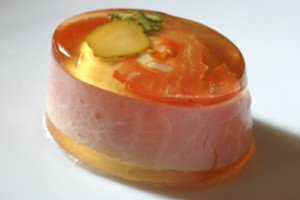When I was 9 years old and in the last year of primary school, I didn’t have class on Wednesdays. My parents considered me old enough to be home without a nanny, so I would make my own lunch. This involved a lot of canned beef ravioli, warmed up in a saucepan. From time to time, scorched ravioli in a saucepan, the reward for getting a bit too engrossed in some paper-cutting activity or other.
It’s around that time that my parents got our first microwave oven, for which I had an odd fascination. I remember very clearly the amazement when we brought the first glass of water to a boil, the solemn warning about not running it empty and not putting anything with metal in it, the panicky fright when I accidentally did (maybe a can of ravioli) and the mini-fireworks that ensued.
Oeuf cocotte is made by cooking an egg in a ramequin along with other ingredients — usually ham and crème fraîche, with an optional topping of grated cheese.
I remember that this microwave oven came with a little recipe booklet. I knew nothing about cooking back then, but I read the booklet carefully, and spotted the one thing that seemed doable: a recipe for Oeuf Cocotte. And that’s how oeuf cocotte went into the Wednesday lunch rotation, keeping the beef ravioli company.
Oeuf cocotte is made by cooking an egg in a ramequin, along with other ingredients — usually ham and crème fraîche, with an optional topping of grated cheese. “Cocotte” is a cute word for a hen, and is also an old-fashioned endearing – or condescending, depending on the tone – term for a girl. So I guess “Oeuf Cocotte” could be accurately translated as “Chick Egg”.
This was, in effect, the very first recipe I ever followed, the very first dish I ever prepared from scratch and unsupervised. Of course, eggs cooked in the microwave are impossibly rubbery, and sometimes they even imploded if left in there for too long. But the pride of eating something I had prepared myself more than made up for it.
And then I grew up, I moved on to other gastronomic pursuits, and somehow the oeuf cocotte was left by the wayside. Until last week, that is, when I bought a package of Boursin — a soft garlic and herb cheese — the lid of which offered a simple recipe for oeuf cocotte, baked in the oven. And that’s what we had for dinner the other day, to deliciously simple and satisfying results.
As you’ll see, this is a very versatile recipe. The only things that need to be there are the egg and the crème fraîche or some sort of fresh creamy ingredient. The rest can be added or omitted depending on what you have on hand. And if you have large ramequins and a large appetite, two eggs can be nice too.

Have you tried this? Share your pics on Instagram!
Please tag your pictures with #cnzrecipes. I'll share my favorites!
Ingredients
- 1 egg
- 1 tablespoon of crème fraîche (alternatively sour cream, Boursin or any other fresh soft cheese)
- fine sea salt
- freshly ground pepper
- paprika or the ground spice of your choice
- a small slice of ham, cut into strips (alternatively cooked bacon, tuna, tofu...)
- a handful of diced vegetables (could be tomatoes, mushrooms, peppers, zucchini, onions...)
- a handful of grated cheese
- a sprinkle of fresh or dried herbs (parsley, chives, cilantro...)
Instructions
- If you've chosen to include diced vegetables that need to be cooked (this is unnecessary for tomatoes for example), heat up a little oil in a small skillet, and sauté the vegetables until tender.
- Preheat the oven to 220°C (430°F). Grease a small ramequin, arrange the ham, vegetables and crème fraîche at the bottom, and break the egg on top. Sprinkle with salt and pepper. If you're using dried herbs, sprinkle them on now. Top with cheese if desired.
- Put the ramequin in a gratin dish, and pour hot water in the dish to reach half the height of the ramequin. Put in the oven for 10 to 15 minutes, depending on how runny you like your eggs.
- Once the eggs are done, sprinkle with paprika and fresh herbs, if using. Serve with crusty bread or warm toast.















